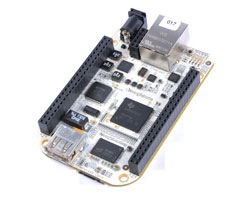Everybody likes the Arduino platform for connecting computing to the physical world. It has plenty of digital and analog input/output ports, serial and USB connectivity and reasonable cost. The
Raspberry Pi device, which came on the scene not too long ago, not only offers a handful of digital input/output ports but also an Ethernet connection, USB and HDMI. Oh and don't forget that Linux runs on the Pi, as well.

What if you'd like to serve up some data that you captured using pressure and temperature sensors over a Web interface? You'd probably need Linux, Ethernet, USB -- along with built-in digital and analog inputs/outputs, right? The
BeagleBone has you covered. It's an offshoot of the venerable BeagleBoard, a fanless, low-cost, low-power, ARM-based Linux computer which has USB ports for peripherals and costs about $150. The BeagleBone also has an ARM Cortex A8 processor, an Ethernet port and USB ports. It includes a bunch of digital and analog input/output pins and a suggested price of about $90. A similar Arduino-based solution might cost you $46 (Arduino Uno) + $30 (Ethernet shield) for a total of $76. The ability to run Linux, with all it's bells and whistles, is surely worth the difference. A few additional details about the BeagleBone.
Capabilities
- The built-in networking comes with all the basic tools baked into Linux. FTP, Telnet and SSH are all available, as is the ability to run your own Web server.
- It's a platform particularly suited for remote access. Log in over the network to get to data or adjust settings.
- Most programming languages are available, including C, C++, Python, Perl, Java, Ruby and shell scripts.
- Using the USB ports, you can connect all kinds of peripherals. The BeagleBone can switch hit between being a USB host and a USB device.
One thing that differentiates the BeagleBone from the Pi is its analog input/output capability. The Pi is digital with one PWM output. On the Beaglebon, there are seven 12-bit (0-4096) analog inputs with a 125 ns sample time and an 0 to 1.8 voltage measuring range. It also has eight PWM capable pins along with all the other digital pins. With the Pi, you have to use peripheral boards to read or control analog devices. That means more cost and complexity. I think there will be a lot of interest in new products and services with Open Source, Open Hardware platforms. The Pi certainly has sparked considerable attention. The BeagleBone product takes physical world computing to the next level. It's a complete package. Not only do we have a fully functioning Linux machine with Ethernet, USB and a mature development community, there's also all that input and output functionality. This thing is much more capable than my old plug computer. So now the bar is set pretty high. Once other manufacturers realize what the BeagleBone is all about, we'll probably see similar offerings in short order.
 What if you'd like to serve up some data that you captured using pressure and temperature sensors over a Web interface? You'd probably need Linux, Ethernet, USB -- along with built-in digital and analog inputs/outputs, right? The BeagleBone has you covered. It's an offshoot of the venerable BeagleBoard, a fanless, low-cost, low-power, ARM-based Linux computer which has USB ports for peripherals and costs about $150. The BeagleBone also has an ARM Cortex A8 processor, an Ethernet port and USB ports. It includes a bunch of digital and analog input/output pins and a suggested price of about $90. A similar Arduino-based solution might cost you $46 (Arduino Uno) + $30 (Ethernet shield) for a total of $76. The ability to run Linux, with all it's bells and whistles, is surely worth the difference. A few additional details about the BeagleBone.
What if you'd like to serve up some data that you captured using pressure and temperature sensors over a Web interface? You'd probably need Linux, Ethernet, USB -- along with built-in digital and analog inputs/outputs, right? The BeagleBone has you covered. It's an offshoot of the venerable BeagleBoard, a fanless, low-cost, low-power, ARM-based Linux computer which has USB ports for peripherals and costs about $150. The BeagleBone also has an ARM Cortex A8 processor, an Ethernet port and USB ports. It includes a bunch of digital and analog input/output pins and a suggested price of about $90. A similar Arduino-based solution might cost you $46 (Arduino Uno) + $30 (Ethernet shield) for a total of $76. The ability to run Linux, with all it's bells and whistles, is surely worth the difference. A few additional details about the BeagleBone.
